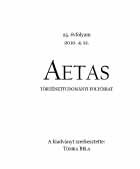Diákfolyóiratok a rendszerváltozás előestéjén és azután
Student periodicals on the eve of the democratic transition and beyond
Author(s): János Gyurgyák, Tibor Valuch, István Bellavics, Márton Szilágyi, Nándor Bárdi, József TakátsSubject(s): History
Published by: AETAS Könyv- és Lapkiadó Egyesület
Summary/Abstract: Beside the usual sections, the papers presented at the conference (May 2010, Szeged) commemorating the launch of Aetas 25 years ago are published in the current issue of the journal in two thematic sections. The first thematic section bears the title “Democratic transition and historiography” and contains papers discussing some of the important problems Hungarian historiography faced after 1990, often presenting these in a wider time perspective. In his essay “The institutions and forums of Hungarian historiography”, Ignác Romsics, looking back on the previous decades of the 20th century, describes the evolution of historical research institutions and historical journals in Hungary. As to the recent past, he emphasizes the increase in the number of research centers as well as the resulting spread of “mediocrity” among scholars. He believes that Hungary does not necessarily need more than seventy universities and colleges, at least two dozens of which has history faculties. Neither quality staff, nor acceptable libraries are available in such quantity. In his views, an obvious structure for history education would be the following: making the BA cycle more like a basic level social science with increased emphasis on language education; making the MA level more professional; and taking the PhD level more seriously using a tutorial educational system. Similarly, the number of institutes, independent of higher education, is also unnecessarily high. For example, there is no need for several of those institutes focusing on 20th-century Hungarian history that were apparently established with ties to political sides or ideologies. As to publications, the author believes that it is an urgent task to launch an English-language historical journal in Hungary. In his paper “Hungarian historiography in an international context – in the past and today”, Gábor Gyáni shows that Hungarian historiography remained relatively isolated internationally throughout the whole of the 20th century. Even after the disappearance of the political confrontation between the East and the West, only a few and inadequate signs of emancipation can be seen in Hungarian historiography. It is despite the fact that a new generation of historians has grown up in the meantime, whose world view is much more international than national provincial. Among them those are the most open to historiographical cosmopolitanism who are more interested in transnational historical approaches than in traditional historical topics and approaches. It is primarily in the areas of social history, the history of mentalities as well as cultural history and theory that international involvement has become almost a natural requirement. Both on the basis of the individual performance of scholars and as a historiographical movement, our social history and history of mentalities seem to be the most marketable internationally.
Journal: AETAS - Történettudományi folyóirat
- Issue Year: 2010
- Issue No: 4
- Page Range: 107-130
- Page Count: 24
- Language: Hungarian

